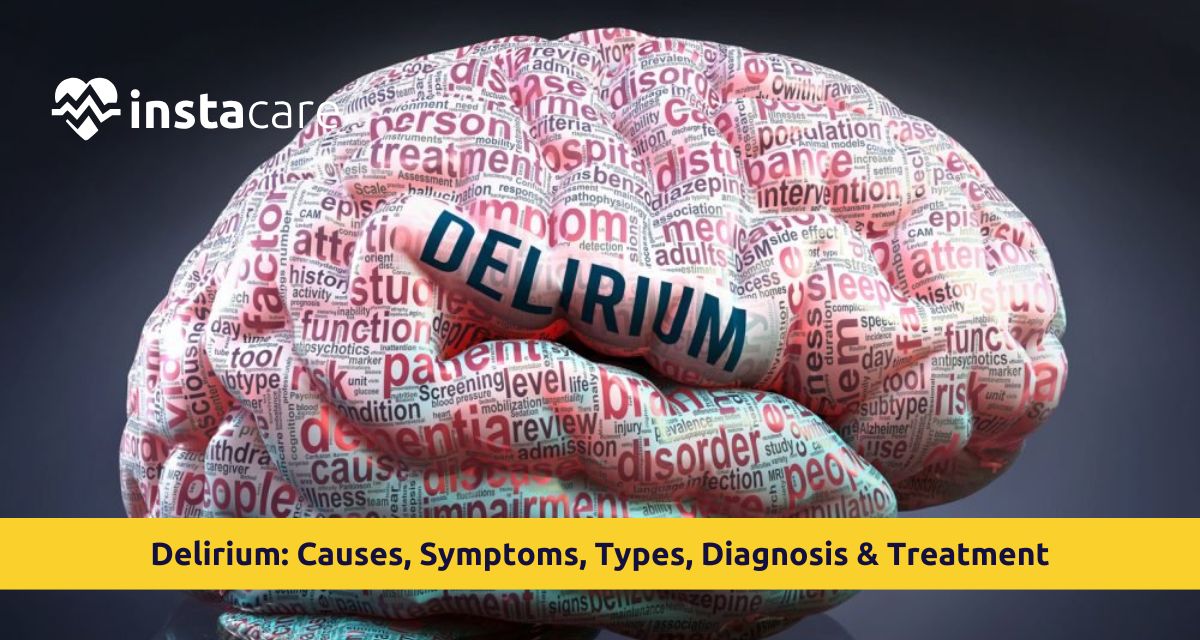What is Delirium?
Delirium is a serious disease that impacts the way the brain works and leads to radical changes in thinking, awareness, and behavior. The disease progresses rapidly, within hours or days, and induces confusion that comes and goes during the day. In comparison to other brain illnesses that progress slowly, delirium progresses rapidly and may be highly distressing to patients and families.
Delirium vs
dementia is a dichotomy one must accept. Dementia takes months or years to develop, but delirium presents acutely and can be cured by treatment. Dementia is a progressive impairment of thinking and memory, whereas delirium causes reversible fluctuating confusion throughout the day.
Delirium in elderly can be experienced by anyone, but more so by some groups of people, primarily the old people in hospitals. Families are able to determine that an individual requires medical care and what will ensue from the treatment because they know the condition.
Causes of Delirium
Delirium causes are numerous that impact the way the brain functions. In most cases, there is more than one cause that acts in combination to create delirium, so it is necessary to identify and treat each possible contributing cause.
Medical illnesses that commonly lead to delirium are:
- Infection, such as pneumonia, urinary tract infection, and infections of the blood
- Dehydration and body fluid and salt disturbances
- Low blood oxygen
- Heart disease, stroke, or other head injury
- Kidney or liver illness that alters the body's function in removing toxins
- Severe pain that is not adequately controlled
Delirium medications can lead to the condition, particularly in older people. Some common medications that have delirium as a secondary effect are:
- Sleeping and sedative medications
- Powerful pain medication such as opioids
- Certain antidepressants and anxiety medications
- Allergy and stomach medications
- Steroids and heart medications
Delirium risk factors for environmental delirium and physical delirium are:
- Hospital stay, particularly intensive care units
- Surgery, particularly major surgery
- Use of a breathing machine or other medical equipment
- Insomnia and disturbed sleep
- Being in a strange environment
- Physical restraints or catheters
- Inadequate diet or poor food intake
ICU delirium is most prevalent because intensive care units have numerous triggers like bright lights, loud noises, frequent disruption, powerful medicines, and the fear of acute illness.
Symptoms of Delirium
Delirium symptoms differ greatly from individual to individual and also shift daily. Most common is a type of confusion that comes and goes, with periods when the person is seemingly more alert and some moments when more confused. Some usual symptoms are:
- Disorientation as to time, place, or identity of people
- Trouble in being able to pay attention or stay focused on conversations
- Memory loss, particularly of recent events
- Disorganized thinking and trouble keeping up with discussions
- Changes in sleep-wake patterns, generally daytime napping and evening or nighttime wakefulness
- Noticing things that are not there (visual hallucinations), hearing things that are not there (hearing hallucinations)
- Anxious, fearful, or suspicious in a non-specific manner
The symptoms typically worsen in the evening or at night, a behavior pattern referred to as "sundowing." This is often very challenging for patients and caregivers at night. Delirium symptoms also have physical manifestations of:
- Changes in movement, either very restless or much slower
- Slurred speech or difficulty speaking
- Coordination and balance difficulties
- Appetite and eating changes
- Emotional changes like crying, irritability, or inappropriate behavior
The family members will notice first most of the time that their loved one is "not feeling like themselves" and that they are behaving strangely or babbling.
Types of Delirium
There are three major forms of delirium based on the behavior of individuals and how active they are. Knowing these forms enables medical professionals to select the optimum form of treatment. Hyperactive delirium is the kind most individuals imagine when they are informed of delirium. Individuals with this condition are:
- Restless and agitated to a certain extent
- Wandering around everywhere, sometimes attempting to leave bed when it is not safe
- Speaking loudly or quickly
- Easily becoming irritable or restless
- Removing medical devices such as IVs or oxygen tubes
- Having trouble sleeping and staying in bed\
Hypoactive delirium actually occurs more frequently but is more difficult to recognize because individuals appear quiet and introverted. Symptoms include:
- Being extremely quiet and not speaking much
- Sleeping excessively during the day
- Moving very slowly or not moving at all
- Not interested in food, visitors, or activity
- Staring space and failure to answer questions
- Depressed or withdrawn from the environment
Mixed delirium is composed of elements of hyperactive and hypoactive types. The individuals alternate between restlessness and withdrawal, sometimes in one day, or even in hours.
The hypoactive type is usually overlooked since individuals are calm and create no disturbance. This type of delirium is equally severe and requires treatment as the other types.
Diagnosis of Delirium
Delirium diagnosis is difficult to diagnose since symptoms fluctuate during the day and can present itself as other illnesses. Practitioners use some tools and tests for the detection of delirium and its severity. Physicians generally seek four significant features:
- Sudden changes in cognition and consciousness, which evolved over a short period
- Difficulty with attention and concentration, which appear intermittently throughout the day
- Alterations in thought, memory, or perception
- Evidence of a medical condition, drug, or other physical etiology as the cause of the symptoms
Physicians and medical practitioners may employ standardized measures to evaluate delirium, including:
- Confusion Assessment Method (CAM) screening for basic symptoms
- Psychological tests of thinking and memory
- Tests of attention such as having patients recite months of the year in reverse
- Observation of behavior throughout the day
Delirium diagnosis also involves:
- Discussion of all medications taken and recent changes
- Laboratory tests to screen for infection, dehydration, or other illness
- Physical examination of the patient for evidence of disease or injury
- Interview with the relatives of the patient regarding recent behavior changes
- History of recent and past illnesses and hospitalizations
Early diagnosis is essential since proper treatment can prevent complications and hasten recovery.
Treatment of Delirium
Delirium treatment is all about recognizing and treating the causes and stabilizing symptoms and rendering patients safe. Treatment is often more than one method combined. The initial step is the recognition and treatment of the causes:
- Treating infection with appropriate antibiotics
- Correcting dehydration and electrolyte imbalances
- Managing pain appropriately without abusing drugs
- Stopping or regulating drugs that may cause delirium
- Re-normalizing oxygenation if necessary
- Treating any other contributing underlying medical conditions
Delirium nursing care is a vital part of treatment and consists of:
- Creating a quiet, calm environment with known items and objects
- Having normal sleep-wake times with light during the day and darkness at night
- Having known voices and family visitors
- Assisting in body needs such as eating, drinking, and toileting
- Prevention of injury and falls with intensive supervision
- Preventing restraint using physical restraints as a last resort
- Giving gentle reorientation regarding time, place, and people
Medication will on occasion be required to treat extreme agitation or disruptive hallucinations, but sparingly and only when necessary for brief duration. Environmental adaptations which are beneficial are:
- Noise and unnecessary interruptions minimized
- Incorporating sufficient light during the day
- Placing clocks and calendars in open view
- Having personal items familiar to them within easy reach
- Keeping caregivers as consistent as possible
Prevention of Delirium
Delirium prevention is usually better than attempting to treat it once it's occurred. Prevention programs that enormously lower risk of delirium are implemented in the majority of hospitals today. Delirium in elderly can be prevented in most cases by:
- Keeping older adults hydrated and well-nourished
- Getting good rest and having normal sleep patterns
- Encouraging movement and getting out of bed if able
- Effective pain management without over-medication
- Giving glasses and hearing aids so individuals can see and hear normally
- Involving the family in the care and visiting regularly
Hospital-based delirium prevention methods include:
- Daily review of all medications to prevent unwanted drugs
- Early catheter and other medical device removal when safe to do so
- Regular nurses and caregivers
- Orientation programs to get patients accustomed to where they are
- Music, relaxation techniques, and normal activities
- Physical and occupational therapy to preserve function
Prevention in surgical patients can include:
- Pre-operative enhancement of health where feasible
- Local anesthesia in place of general anesthesia where feasible
- Effective pain control post-surgery
- Early ambulation and nutrition of patients as soon as it is safe and possible
- Closely observing the early warning signals of complications
Conclusion
Delirium is a serious but generally treatable disease with changes in thinking and behavior. Familiarity with the signs, causes, and therapy will allow families and medical personnel to cooperate and administer the best therapy for the patient. While delirium is intimidating for everyone, most individuals recover perfectly well with therapy.
Delirium prognosis is usually good when the condition is diagnosed early and etiology is treated in a timely manner. Un-treated delirium, on the other hand, can result in prolonged hospital stay, occurrence of complications, and slowing down of recovery from illness overall.
The most important is to recognize early, treat the underlying causes early, and supportive treatment that includes dignity and comfort for recuperation. Family input and the insight of the condition are pivotal in treatment and prevention of such a difficult syndrome.
Please book an appointment with the
Best Neurologist in Lahore, Karachi, Islamabad, and all major cities of Pakistan through
InstaCare, or call our helpline at 03171777509 to find a verified doctor for your disease.

